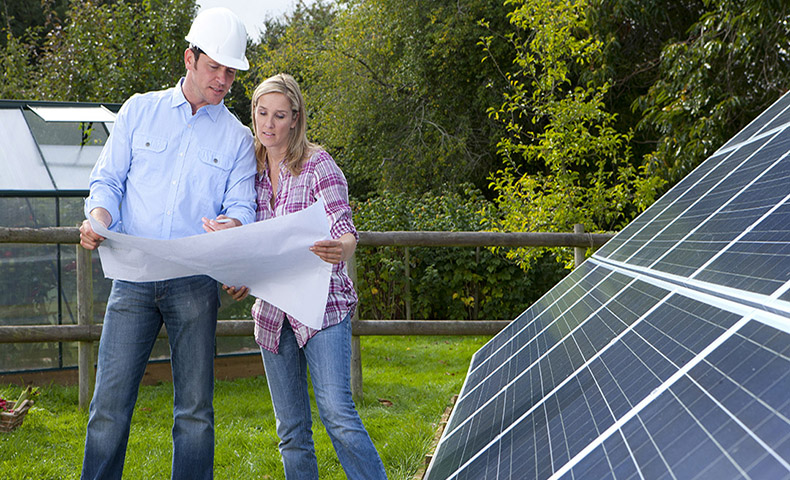
Starting in 2020, all new single-family homes built in California are mandated to have solar panels. Many developers are already incorporating photovoltaic (PV) modules in new properties ahead of this requirement. Those panels are meant to help the homeowners save on their electric bill.
But how much power can solar panels generate? Is it enough to power all the devices and appliances in an average home?
The size of your system
The answer to this question depends in great part to the size of your home solar energy system and how much of your electricity do you want to offset with it.
According to the US Energy Information Administration, an average American household uses 895 kWh per month. Adding it up, the average power consumption is about 11,000 kWh per year.
For that typical homeowner, 28-34 solar panels will cover 100% of energy usage, assuming that each one of those PV modules has a 250-watt rating.
If you want to know how many panels are needed to cover your individual energy needs and how much it will cost you, you can easily find out with the Hahasmart price checker. Just provide your address and your average monthly utility bill and you’ll get the actual price of solar panels and inverters - which are the most critical parts of a solar powered system - as well as provide you with an estimated cost of installation based on thousands of completed solar projects in your area.
They’ll even provide you with an estimated buyback period, the point where the electricity savings achieved with your solar array cover the purchase of your residential solar panels and your system becomes free.
In addition, they’ll connect you with their installer network to get your residence equipped with solar power as possible.
The number of appliances in your home
Most homes have a refrigerator, washer and dryer, television and a computer/laptop. But the size of the family and the ages of their members greatly influences how much energy they use and the number of appliances in their home.
One way you can help reduce total power consumption is by taking some easy steps. For instance, try not to overload the refrigerator with food. That way you keep its power consumption low and the food cold. Installing energy efficient appliances and light bulbs also helps.
According to the National Renewable Energy Laboratory, for every $1 spent in conservation or energy efficiency, you could save $2 or more in solar electric system cost. For example, a new energy efficient refrigerator, which can cost $1,000, could reduce your energy consumption by 360 kilowatt-hours per year compared to the old model.
The Department of Energy (DOE) also recommends keeping a log of your energy consumption. “For example, you could record the cooking time each time you use your microwave, work on your computer, watch your television, or leave a light on in a room or outdoors,” it notes.
There are also energy monitoring systems available to provide you with a detailed track of your energy usage. This might be helpful if you really want to find out how much power you use.
“In addition to providing information on the energy consumption of your appliances, these monitors help you understand where and when you use the most energy, allowing you to develop strategies to reduce your energy use and costs,” the DOE explains.
Efficiency
Something else to keep in mind when determining if solar panels can cover 100% of your electricity needs is solar panel efficiency and your location.
The average panel in a domestic solar power system can convert 15%-22% of the sun’s energy into electricity. But this can be affected by shading, temperature and angle. You want to make sure the panels are not obstructed partially or during part of the day, that they are positioned where they'll have maximum sun exposure and that there's plenty of space between them and the roof to allow for air flow to bring down temperatures around them.
All of this will mean better energy production, fewer panels you will need and the more extra electricity you’ll be able to send to the utility if there’s net metering available. Because you still need to be tied to the grid for when panels don’t produce power (at night) or when that power is reduced by clouds and rain.
Something else to keep in mind is that most areas of the United States only receive around four to five hours of peak sunlight on an average day, with sunlight being considerably less intense during the winter months. That means that even with a 5-kilowatt solar installation, you still might not be able to generate all the electric power your household needs on a daily basis.
A properly-sized domestic solar power system with Tier 1 solar panels will make sure that all your energy needs are met and you can continue to generate electricity from the sun for years.
Investing in a solar installation will provide you with ample savings in your electric bill and can power all the appliances you have in your home and even generate extra energy to be sold to the utility grid.
For more information relating to going solar, don't forget to visit our solar blog section for more handy guides and articles.


Input your address to see if it is solar friendly and how much you can save with solar.
Great. Your address is perfect for solar. Solar incentive is still available. Select monthly utility cost and calculate the size of solar system you will need now.
| kw System size | years Payback period | Lifetime savings |
No money down, 100% finance is available.
|
|
Sign up to understand more about solar panel costs, see quote right away |
Comments